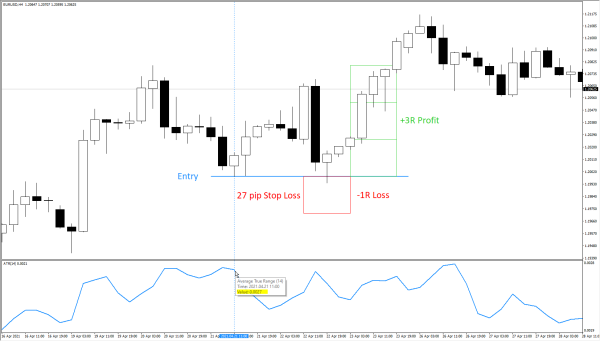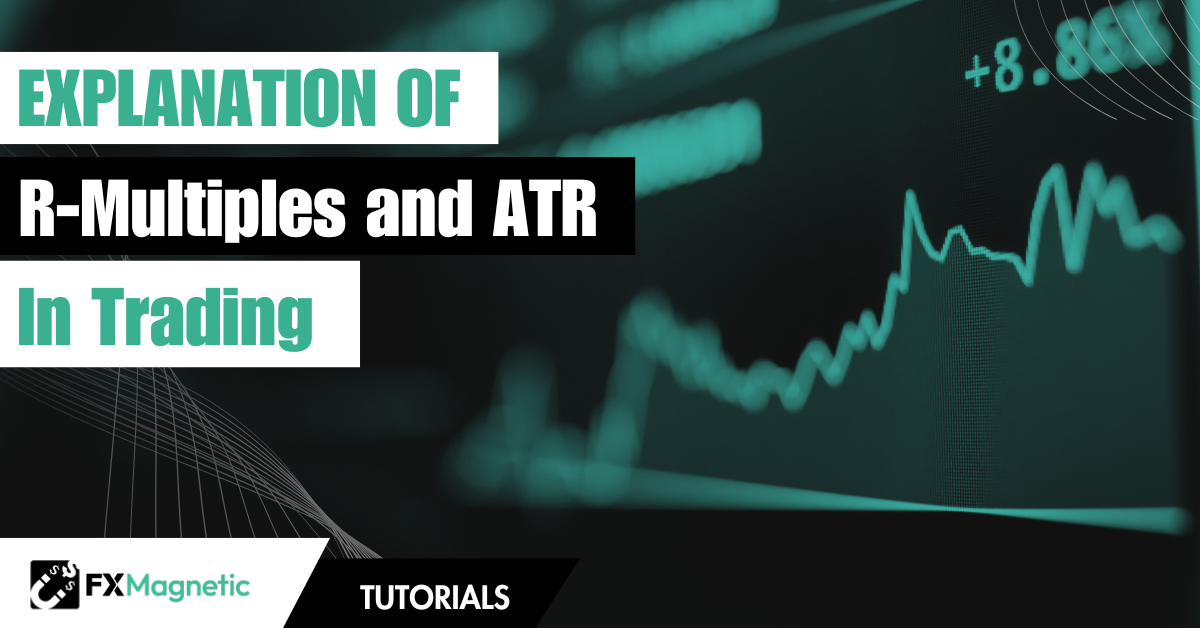In this tutorial, we will explore two powerful tools for managing risk and understanding market volatility: R-multiples and Average True Range (ATR). By combining these concepts, traders can improve their risk management by having a standardized approach to measuring stop loss and take profit levels, therefore
What Are R-Multiples?
R stands for risk and R-Multiples is a method to measure profits or losses relative to that risk.
Example:
- If you risk $100 (Your 1R) and make $200, that’s a +2R profit.
- If you lose $50, that’s a -0.5R loss.
- If you risk 1% (your 1R) and make 5%, that’s a +5R profit.
- If you lose 0.5%, that’s a -0.5R loss.
- If you risk 5% (your 1R) and make 20%, that’s a +4R profit.
- If you lose 2.5%, that’s a -0.5R loss.
R-Multiples keep your trading results consistent and easy to track. It provides a standardized way to measure and compare trades, regardless of account size or dollar amount risked.
What Is Average True Range (ATR)?
ATR measures market volatility. It shows how much a price typically moves during a specific time period. To further explain:
- If ATR is 20 pips, this means the market moves an average of 20 pips per candle (from wick to wick).
- ATR helps you set stop-loss and take-profit levels (measured in pips) based on actual market statistics.
Example:
- Low Risk, High Reward: ATR is 30 pips. You risk IR (30 pips) with a target of 90 pips. If the trade hits your target, that’s a +3R profit.
- High Volatility Trade: ATR is 50 pips. You risk IR (50 pips) but close early with a profit of 25 pips. That’s +0.5R.
- Stop-Loss Hit: ATR is 40 pips. You risk IR (40 pips), but the market moves against you. Your stop-loss is hit, and you lose -IR.
By combining R-Multiples and ATR, you can better manage risk and adapt to market conditions. It keeps your trading focused and controlled.

Here’s a screenshot on how R-Multiples and ATR can be applied to a simple support and resistance trading strategy.
Combining R-Multiples and ATR

Above is a screenshot where we demonstrate how R-Multiples and ATR is used with FxMagnetic MACD Trader indicator to spot potential trade entries and automatically measure risk, stop loss, and take profit levels.
n this example:
- We traded USDCAD in a 15-minute timeframe.
- The current ATR during the entry is about 0.0006 or 6 pips.
- The ATR Multiplier for SL is set to 2.0 (or about 12 pips) and TP to 14.0 (or about 84 pips).
- Our trade resulted in a +6.98R.
By using R-multiples and ATR together, you can better manage risk. It can help you maximize the market movements by using actual statistics using candle data. This is more advantageous than settling for fixed stop loss.
Benefits of Using R-Multiples and ATR
- Adaptation to market volatility.
- Improves risk-reward ratios by maximizing the market movements.
- Provides a consistent way to track and compare trades.
- Reduces decision fatigue.
- It makes the risk and trading approach logical.
Considerations and Caveats
Before implementing R-Multiples and ATR in your trading strategy, it’s essential to consider the following:
- Volatility varies across different currency pairs. For example, an average daily candle movement of 50 to 60 pips for GPB might be considered normal but volatile for EUR/USD.
- Low ATR periods may lead to frequent losses. Periods of low volatility means lower ATR leading to tighter stop loss. The price would most likely hit it before reaching your target. Strict adherence to money and risk management is the best way to minimize your losses.
- Optimal R-Multiplier and ATR may vary. It differs depending on the currency pair, market conditions, and time frame you are focusing on. It’s better to test and optimize to find the setting which fits your style and gives you the most acceptable results.
- Risk management is king. While using R-Multiples and ATR can help improve your risk-reward ratio, it’s still essential to practice proper risk management. Always ensure that your risk per trade is appropriate for your account size and risk tolerance.
- Backtesting and forward testing are essential. Before using R-Multiples and ATR in your live trading, thoroughly backtest your strategy to assess its performance in different market conditions. Once you’re confident in your approach, forward test it in a demo environment or with a small account to validate its effectiveness.
- Adapt to changing market conditions. Volatility changes over time depending on market conditions. So, apart from adjusting and recalibrating your R-Multiplier and ATR, as well as your trading strategy, always stay informed with market events.
By keeping these considerations in mind and applying R-Multiples and ATR thoughtfully, you can work towards improving your trading performance and managing your risk more effectively.
